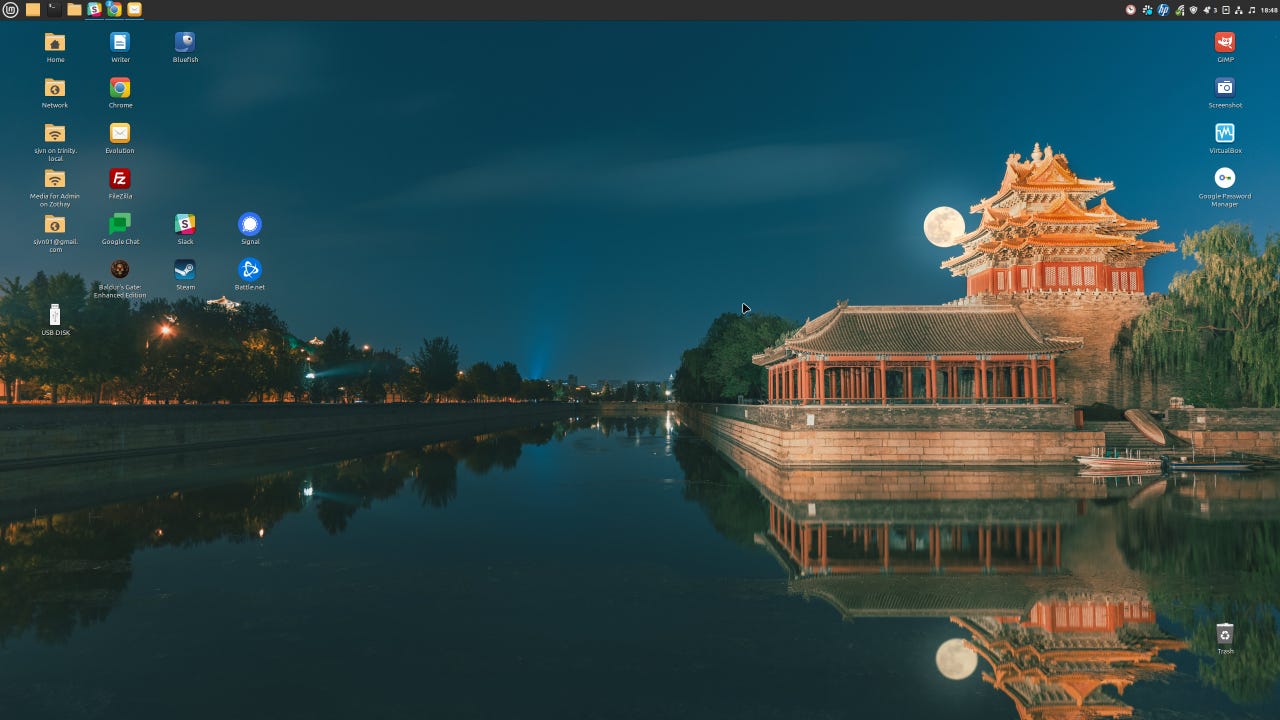
































The Linux Mint community has once again released a top-tier Linux desktop: Linux Mint 21.3 Virginia. I've used more Linux distributions than most people, and Mint is my favorite desktop distro.
My bias starts with Mint's Ubuntu 22.04 Long Term Support (LTS) and Linux kernel 5.15 foundation. It's a stable, reliable operating system for both new and experienced users. Since it's also a Mint LTS, you can use it without any worries until April 2027.
Also: The best Linux laptops
Like all Linux desktop distros, Virginia isn't just a desktop operating system, it includes all the software you need. The distro comes with LibreOffice 7.3.7 for office productivity, Thunderbird 115.16.0 for email and calendaring, GIMP 2.10.30 for graphics editing, and Firefox 121.0.1 for web browsing.
But if you don't like these default applications, no worries. It's simple to install new software programs on Linux. Just like a smartphone, you simply go to the software store -- in Mint it's called Software Manager -- search for your program, and download and install it.
Also: Why don't more people use desktop Linux? I have a theory you might not like
For example, if, like me, you prefer Chrome, all you have to do is search for "Web browser", and you'll have three dozen web browsers to choose from. I found Chrome from a selection that included Microsoft Edge, Brave, Opera, and -- a real blast from the past -- Mosaic. A minute later, I was in business.
And when I call it a software store, it's important to note that almost all these applications are free. The Software Manager also includes application ratings to help you make informed decisions about which program you want to use. For example, I'm not a fan of Thunderbird. My favorite e-mail program is GNOME Evolution. And, yes, it's also free.
The Software Manager's refreshed user interface also enables you to download and install Flatpak-packaged applications. These are containerized applications that can run on any Linux distro. Mint does not, however, support Snap-packaged applications by default. But it's easy to add Snap support to Mint if you want access to Snap programs. I do it all the time.
If you don't like Flatpak or Snap because their containerized applications take up more drive and memory space, that's no problem. Software Manager makes it easy to see the difference between a conventional and a Flatpak installation. And don't bother adding Snap support if you don't want to.
Also: How to replace Windows with Linux Mint on your PC
The abundant RAM and storage in modern computers means I never worry about running out of room. Linux applications tend to be smaller than their macOS and Windows rivals.
Linux Mint also comes with its own homebrew apps. The ones I find most interesting in this release are: Hypnotix, an IPTV tuner and viewer; Warpinator, a simple local area network file-sharing utility; and Bulky, an application for easily renaming multiple files and directories.
Hypnotix is a great way to stream videos to your Linux Mint-powered PC.
Hypnotic now supports custom and favorite channels. Behind the scenes, it also comes with a very handy yt-dlp update, which enables the software to do a better job of presenting YouTube videos. Warpinator's new features enable you to connect to networked drives manually via IP or QR codes. However, I would be hesitant about connecting to an otherwise unknown device using a QR code. Finally, Bulky supports thumbnails, drag-and-drop files, and directory moves.
While Linux Mint supports many Linux desktop environments, such as MATE and Xfce, its default environment -- and my favorite -- is Cinnamon. This fork of the GNOME 2.0 environment is simple, clean, and easy to use. I think it's the best desktop environment out there.
Also: 8 things you can do with Linux that you can't do with MacOS or Windows
Linux Mint 21.3 boasts the newest version of Cinnamon, Cinnamon 6.0. In this release, more optional features, called spices, enable you to do such things as make a bootable USB stick from its Nemo file manager.
You can also now use the Wayland display server. However, this protocol is optional. And unless you want to live on the wild side of Linux, I wouldn't bother with it. While Wayland's been in the works for years now, it's still not ready for prime time. Indeed, Mint's developers don't plan on using it until 2026.
Without Wayland, the Cinnamon interface remains quick and snappy. I've already moved my main desktop -- a 2020 Dell Precision 3451, with an Intel 8-core 3GHz i7-9700 CPU 16GBs of RAM, and a 512GB SSD -- to Mint 21.3, and it runs great. Unlike Windows, where operating system "upgrades" almost always bring slower performance, every step forward with Linux Mint gives you a faster machine.
In fact, Linux Mint will run on pretty much any computer. You're good to go if your PC has 2GB of RAM and 100GB of storage, any graphics card, and a monitor that supports a 1024
 Tags chauds:
affaires
Tags chauds:
affaires